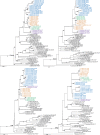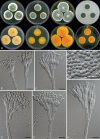Penicillium diversity in Canadian bat caves, including a new species, P. speluncae
- PMID: 32467912
- PMCID: PMC7250010
- DOI: 10.3114/fuse.2020.05.01
Penicillium diversity in Canadian bat caves, including a new species, P. speluncae
Abstract
Penicillium species were commonly isolated during a fungal survey of bat hibernacula in New Brunswick and Quebec, Canada. Strains were isolated from arthropods, bats, rodents (i.e. the deer mouse Peromyscus maniculatus), their dung, and cave walls. Hundreds of fungal strains were recovered, of which Penicillium represented a major component of the community. Penicillium strains were grouped by colony characters on Blakeslee's malt extract agar. DNA sequencing of the secondary identification marker, beta-tubulin, was done for representative strains from each group. In some cases, ITS and calmodulin were sequenced to confirm identifications. In total, 13 species were identified, while eight strains consistently resolved into a unique clade with P. discolor, P. echinulatum and P. solitum as its closest relatives. Penicillium speluncae is described using macroand micromorphological characters, multigene phylogenies (including ITS, beta-tubulin, calmodulin and RNA polymerase II second largest subunit) and extrolite profiles. Major extrolites produced by the new species include cyclopenins, viridicatins, chaetoglobosins, and a microheterogenous series of cyclic and linear tetrapeptides.
Keywords: Genealogical Concordance Phylogenetic Species Recognition (GCPSR) concept; Pseudogymnoascus destructans (Pd); Thysanophora; new taxon; secondary metabolites; sect. Fasciculata.
© 2020 Westerdijk Fungal Biodiversity Institute.
Figures





References
-
- Afendi FM, Okada T, Yamazaki M, et al. (2012). KNApSAcK Family Databases: Integrated Metabolite–Plant Species Databases for Multifaceted Plant Research. Plant and Cell Physiology 53: e1. - PubMed
-
- Akaike H. (1974). A new look at the statistical model identification. IEEE Transations on Automatic Control 19: 716–723.
-
- Anelli P, Peterson SW, Haidukowski M, et al. (2018). Penicillium gravinicasei, a new species isolated from cave cheese in Apulia, Italy. International Journal of Food Microbiology 282: 66–70. - PubMed
LinkOut - more resources
Full Text Sources
